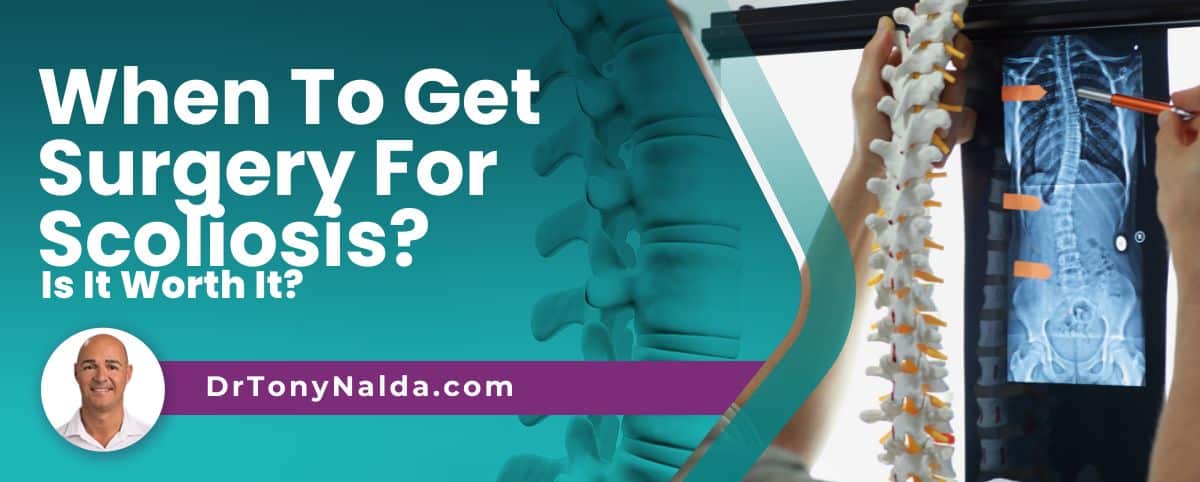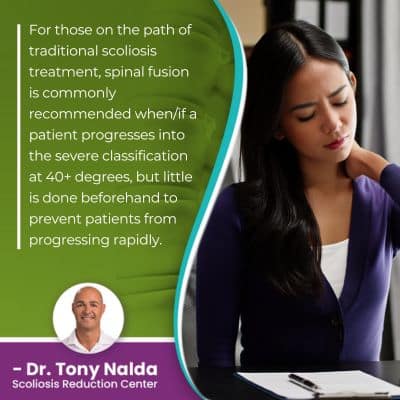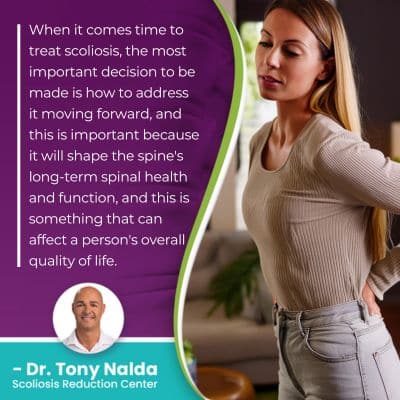When To Get Surgery For Scoliosis? Is It Worth It?

Many scoliosis patients don't need surgery, particularly those that are diagnosed early and treated proactively. While there are never treatment guarantees, the sooner nonsurgical treatment is started, the less likely it is that future surgical treatment will be needed.
Getting surgery for scoliosis isn't always worth it in terms of long-term spinal health and function. While it can straighten a bent spine, a fused spine is weaker and less flexible than one that's treated with a conservative nonsurgical treatment approach.
As how a scoliosis diagnosis is responded to is so important, let's start with how the two main scoliosis treatment approaches respond.
Table of Contents
Scoliosis Treatment Options
When patients are diagnosed with scoliosis, they have developed an unnatural sideways bending and twisting spinal curve that's progressive, meaning its nature is to get larger and more severe over time.
The spine's natural and healthy curves make it stronger, more flexible, and better able to handle mechanical stress incurred during movement, so if the spine loses one or more of its healthy curves, the biomechanics of the entire spine are disrupted.
The most important decision patients have to make is how to treat their condition moving forward; as a progressive condition, there is no curing scoliosis as treatment is more about managing a life-long condition.
There are a number of famous athletes and celebrities that are thriving, despite being diagnosed with scoliosis in childhood; a scoliosis diagnosis doesn't have to mean a life of limitations, particularly with early detection and intervention.
So how a diagnosis is responded to with treatment can shape a person's long-term spinal health, a factor that can affect a person's overall quality of life.
Traditional scoliosis treatment is more reactive than proactive as it doesn't have a strategy for addressing scoliosis while mild, instead reacting once a certain amount of progression has already occurred, rather than proactively working towards preventing it.
Traditional scoliosis treatment funnels patients towards invasive and costly spinal fusion surgery which while capable of straightening a bent spine and stopping scoliosis from progressing, can cost the spine in terms of its overall strength and function.
What is Spinal Fusion Surgery?
Spinal fusion surgery has the goal of stopping scoliosis from getting worse, and this involves fusing the curve's most-tilted vertebrae at its apex into one solid bone, and attaching rods to the spine with surgical screws to hold it in place; the cost of this, however, can be the spine's flexibility and range of motion.
There are also different types of fusion such as vertebral body tethering that involves using flexible and adjustable tethers instead of metal rods, and this is seen as a less-invasive type of fusion that can be ideal for young patients whose spines are still growing.
While some patients maintain enough flexibility above and below the fusion site, many experience a noticeable loss.
In addition, a fused spine is simply not as strong so is more vulnerable to injury, and many patients also experience increased back pain at the fusion site.
Spinal fusion surgery comes with the risk of infection, nerve damage, adverse reaction to hardware used, and excessive bleeding, and of course, those risks increase alongside any complications that occur doing the procedure.
The long-term effects, however, of living with a fused spine 30, 40, 50+ years down the road aren't fully documented, and the younger a patient is at the time of the fusion, the longer the hardware has to remain performing optimally inside the body.
 For those on the path of traditional scoliosis treatment, spinal fusion is commonly recommended when/if a patient progresses into the severe classification at 40+ degrees, but little is done beforehand to prevent patients from progressing rapidly.
For those on the path of traditional scoliosis treatment, spinal fusion is commonly recommended when/if a patient progresses into the severe classification at 40+ degrees, but little is done beforehand to prevent patients from progressing rapidly.
So some risks associated with the surgical procedure itself, along with long-term effects of spinal fusion surgery can include:
- Excessive blood loss
- Nerve damage
- Adverse reaction to hardware
- Infection
- A lengthy recovery period
- A spine that's weaker and more vulnerable to injury
- A spinet that's less flexible and has a reduced range of motion
- Increased back pain at the fusion site
- Hardware malfunction over time
- Subsequent surgeries needed
So according to traditional scoliosis treatment, a person should get surgical treatment if they have progressed to severe and show signs of continued progression, but the reality is that many patients with scoliosis don't need surgery.
Nonsurgical Conservative Scoliosis Treatment
According to conservative scoliosis treatment , surgery should be a last resort, after less-invasive types of treatment have first been attempted.
Conservative treatment is what patients of the Scoliosis Reduction Center benefit from, and the approach is integrative, combining multiple treatment disciplines so conditions can be impacted on all levels.
As a structural spinal condition, scoliosis has to be primarily impacted on a structural level, and this involves chiropractic care that uses a variety of techniques and manual adjustments to reposition the curve's most-tilted vertebrae back into alignment with the rest of the spine.
Improving spinal alignment means restoring as much of the spine's natural curves as possible by reducing the size of the unnatural spinal curve, and once I see these types of structural results, physical therapy and scoliosis-specific exercises are applied with the goal of increasing core strength so the spine is optimally supported and stabilized by its surrounding muscles.
Physical therapy can also address any related muscular imbalance, improve posture, and activate specific areas of the brain for improved brain-body communication.
 For young patients who are still growing, corrective bracing can help by pushing the spine into a corrective position, complementing the other treatment disciplines.
For young patients who are still growing, corrective bracing can help by pushing the spine into a corrective position, complementing the other treatment disciplines.
Rehabilitation is the final and continuous phase of treatment because as a progressive condition, there is no curing scoliosis; treatment is more about managing an ongoing condition, and this can involve continued chiropractic care and the prescription of a series of scoliosis-specific exercises that can easily be performed at home to further heal the spine.
So the benefits of nonsurgical scoliosis treatment over spinal surgery can include:
- Less invasive
- Less costly
- No recovery period
- Treatment is aligned with the spine's natural movement-based design
- Preserves the spine's strength
- Preserves the spine's natural range of motion
- Preserves the spine's natural function
- The function and strength of the spine isn't permanently altered
Conservative treatment doesn't permanently alter the strength and function of the spine, so is a safer more natural approach than spinal fusion; surgery has the goal for stopping a scoliotic spinal curvature from progressing by holding it in place.
When it comes time to treat scoliosis, the most important decision to be made is how to address it moving forward, and this is important because it will shape the spine's long-term spinal health and function, and this is something that can affect a person's overall quality of life.
Conclusion
So the question of when to get surgery for scoliosis will have different answers; supporters of the traditional scoliosis treatment approach would recommend surgery for severe scoliosis, while conservative treatment providers would say that many scoliosis patients don't need surgery.
There was a time when traditional scoliosis treatment was the dominant choice, and patients were often funneled in the direction of surgery simply because other treatment options weren't presented to them; I want patients to be fully aware of all scoliosis treatment options available so they can make informed decisions.
Here at the Center, I spend a lot of time explaining the different potential results of the two main scoliosis treatment approaches, and patients are then informed and can ensure they are making the best treatment choice for themselves.
Spinal fusion surgery still has a place in the treatment of scoliosis, particularly in cases that are very severe, have been left untreated, or are atypical.
Typical cases of scoliosis involve idiopathic scoliosis with curves that bend to the right, away from the heart, but in atypical cases of scoliosis with known causes, curves can bend to the left, towards the heart, and these types of cases can be particularly severe and require surgical treatment.
Idiopathic scoliosis accounts for approximately 80 percent of known diagnosed cases, while the remaining 20 percent consists of types associated with known causes: neuromuscular scoliosis, congenital scoliosis, and degenerative scoliosis.
When metal rods are attached to the spine to maintain its straight alignment, the hardware attached is permanent, and if the surgery is unsuccessful, the only recourse is more surgery, and the risks increase with age and each subsequent procedure.
So for those wanting to forgo a surgical recommendation or who want to try a less-invasive treatment option first, the results of conservative nonsurgical scoliosis treatment speak for themselves.
Dr. Tony Nalda
DOCTOR OF CHIROPRACTIC
After receiving an undergraduate degree in psychology and his Doctorate of Chiropractic from Life University, Dr. Nalda settled in Celebration, Florida and proceeded to build one of Central Florida’s most successful chiropractic clinics.
His experience with patients suffering from scoliosis, and the confusion and frustration they faced, led him to seek a specialty in scoliosis care. In 2006 he completed his Intensive Care Certification from CLEAR Institute, a leading scoliosis educational and certification center.
About Dr. Tony Nalda
 Ready to explore scoliosis treatment? Contact Us Now
Ready to explore scoliosis treatment? Contact Us Now





